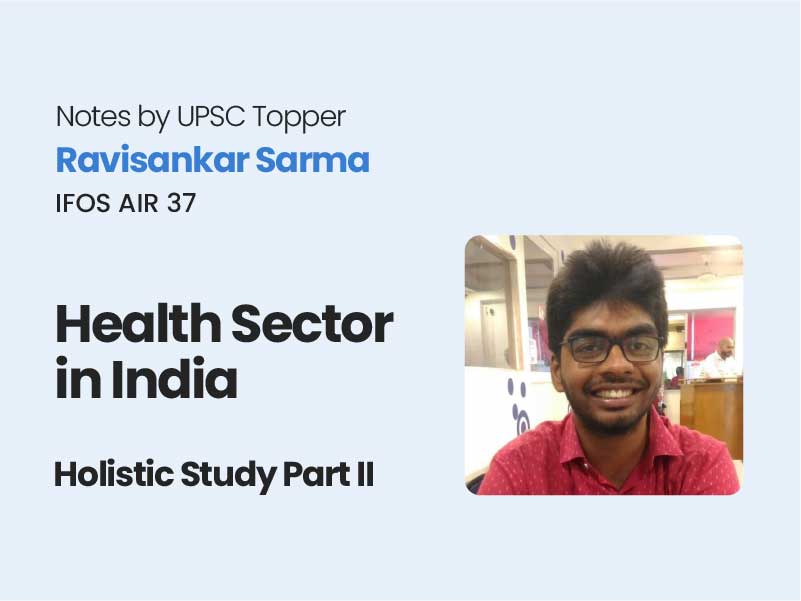Companion@360 → 7 Month programme to sharpen your writing skills → REGISTER NOW

Parameters for Assessing Health Sector
Total Fertility Rate
- Ideally should be around 2.1 – Currently around 2.3
- Huge regional disparity with backward regions having higher TFR close to 37 (Bihar) and other regions having lower fertility rate (as low as 1.24 in Sikkim) – National Family Health Survey
- Hence targeted differential policy is required
In areas of High TFR – Solutions
- Empower women by providing with skilling and livelihood opportunities – As women are empowered and gain voice within households gradually the population decreases. A high correlation currently exists between women’s illiteracy levels and TFR rates as witnessed in the EAG states.
- Poverty Alleviation: The lower economic rung in the society always looks upon children as economic assets rather than liabilities. Hence alleviating them out of poverty can have a contraction effect on population
- Family Planning and Use of Contraceptives: Precisely what Mission Parivar Vikas under MHFW seeks to implement targeting the UP, Bihar belt
- Discouraging early marriages: Sukanya Samriddhi Yojana and Beti Bachao Beti Padao
- Provide opportunities and scholarships for higher education of women: The West Bengal government’s Kanyashree Prakalpa is an astute initiative in this direction.
Infant Mortality Rate
Number of deaths per 1000 live births in 1 year
India – 41 per 1000 live births
Neo-Natal Mortality: 29 per 1000 live births
Causes of Child Mortality
- Maternal Health Issues: Poor nutritional status of the mother can affect the survival of the child. NFHS notes 20% children born with low birth weight in the country having high risk of mortality
- The government has launched the National Nutrition mission with convergence across departments. This can address the nutrition requirements of the mother and child through the Anganwadis
- Poor Institutional delivery: The lack of expertise in delivery, poor antenatal and neo natal health services can cause infant mortality. The lack of infrastructure like warm towels can increase risks of infant mortality
- The PM Matritva Suraksha Abhiyan and the PM Janani Suraksha Yojana emphasizes on providing vital ante-natal and neo-natal care to reduce IMR
- Vulnerability to Diseases: The lack of hygiene and sanitation facilities render the children vulnerable to pneumonia and diarrhoea. Diarrhoeaà Low capacity of nutritionà Stunting, Wasting and Child mortality
- The Swachchh Bharat Abhiyan and the NRDWP aim to provide households with clean drinking water
- Under Nutrition: The NFHS notes that 33% of under 5 deaths in India are due to malnutrition among children
- Through the ICDS, NNM and mid day meal schemes, the government aims to address issues of malnutrition and hidden hunger
- Exclusion from Immunization: India is yet to achieve 100% immunization. This renders children vulnerable to vaccine preventable diseases like Japanese encephalitis as witnessed in the Gorakhpur tragedy.
- Mission Indradhanush aims to universally immunize children and mothers from 11 vaccine-preventable diseases by 2022.
- Gender Discrimination: IFPRI’s GHI illustrates that Indian girl child is relatively deprived to the boy in access to nutrition and healthcare. The Economic Survey notes a similar son preference culture. This may lead to increased mortality among the ‘unwanted girl children’
Maternal Mortality Rate (MMR)
Number of delivery deaths per 1 lakh live births: 167 MMR in India (RGI 2013)
Why delivery Deaths?
- Lack of institutional delivery
- Insufficient antenatal and neo natal care
- Forced Re-entry into work after pregnancy
- Adolescent Pregnancy and Child Marriages
- Insufficient spacing between child births
- Gender Discrimination
- Access to nutrition
- Agency of Reproduction
- Agency to access health care services
- Poor Nutrition: 53% of women in the reproductive age in India suffer from anaemia according to the
Schemes to reduce IMR and MMR
- Janani Suraksha Yojana – MHFW
- Incentivizing institutional delivery by providing cash incentives
- Targeted delivery differentiating between low performing and high performing states
- Free neo-natal care and monitored ASHA linked antenatal care
- Under NRHM
- Mathrithva Suraksha Abhiyan
- Free ante-natal care on 9th of every month
- Private doctors are free to voluntarily participate and render their services
- Integrated Child Development Services (ICDS): Maternal factors have a key bearing on the child health beyond the pregnancy. It is therefore prudent to consider them as a single unit rather than compartmentalizing them.
- Free Supplementary Nutrition and Immunization
- Beneficiaries – Pregnant women, Children and lactating Mothers
- Maa – Breast Feeding Initiative – Mother’s Absolute Affection
- To reduce under five mortality of children
- Generate adequate awareness among mothers regarding benefits of breastfeeding
- Strengthen inter-personal communication through ASHA
Under Nourishment parameters
Global Nutrition Report – IFPRI and IDS
Parameters used: Stunting, Wasting and Anaemia
Global Hunger Index by IFPRI
Stunting, Wasting, Child Mortality and Undernourishment
Child Sex Ratio
The number of females to 1000 males in the population.
The Economic Survey elucidates a strong meta son preference as parents continue to have children until they get the desired number of sons. This leads to a skewed sex ratio in different directions: favouring males in case it is the last child and females in case it is not the last child.
